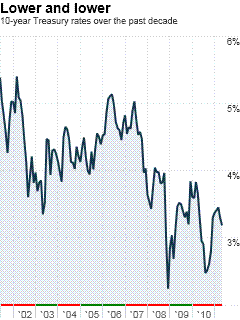等待美联储加息——时间:2018年

|
最初这个问题似乎有些遥远。但随着大宗商品价格飙升,批评美联储(Federal Reserve)的零利率已成为美国人茶余饭后的新话题。负面舆论报道和就业增加当然都不支持零利率政策的延续,对吗? 答案是“否”。高盛(Goldman Sachs)经济学家发布的一份报告认为,即将到来的、受到鹰派欢迎的美国政府紧缩开支潮,将令央行鸽派人士长期占据上风——时间上可能持续至本十年的后半段。 高盛报告指出,美国庞大的财政赤字以及担心美国财政政策收紧可能危及弱势复苏的顾虑,或使联邦基金利率在未来六年内维持近于零的水平。如果你正打算在后院树一个托马斯•霍恩的雕像以庆祝加息时代重来,现在不用着急。 “美联储只能维持现有货币政策,以缓解财政整固对经济增长的负面影响。”高盛经济学家斯文•贾里•斯特恩表示,“因此,伴随着财政整固的推进,政策利率——可能还有中长期利率——很可能会在很长一段时间内低于正常水平。” 在通胀滋生之际,伯南克们如何能为自己的不行动找到合理解释?答案就在于一个长期恣意挥霍的国家很难一下子缩减超额开支,不管全球的保罗•瑞恩们怎么说。 首先想想美国膨胀的预算。原始赤字,即政府开支(剔除利息支出)减去税收收入的余额,今年有望达到惊人的7.7%——这样的水平已促使国际货币基金组织(International Monetary Fund)敦促美国采取更有效的行动。 即便美国的政治领导人能很快就缩减开支和加税一揽子方案达成一致——在负债达到上限之时,这种可能性很低——要控制住如此庞大的赤字,也需要多年的时间。 高盛提到了国际货币基金组织进行的一项富国财政整固调查结果,调查将政府成功紧缩开支所需的平均时间定为6年。 这是一个让人望而生畏的数据。但大多数此类成功案例——从20世纪80年代中期的爱尔兰到20世纪90年代中期的芬兰、意大利和瑞典——都有一个显著的共同特征:短期利率平均下调5.5个百分点。 美联储没法这么做,因为早在2008年12月份,美联储就已将联邦基金利率降至当前略高于零的水平了。 “由于联邦基金利率近于零,”斯特恩写道,“可能无法用货币宽松政策来为财政支出调整政策配套,除非美联储决定再次实施资产收购计划(我们认为这种可能性很低)。” 这意味着即便美国的财政整固政策取得成功,总体来看,美联储也可能十年按兵不动。假如从2008年开始,估计华盛顿的国会议员们能在今年余下时间里制定一个大幅改革计划,6年时间意味着2018年美国可能仍在整合。而且,这是假定在明年的美国总统大选前就能完成一些事情。太乐观了! 这样的时间表可能让那些将脑袋埋在沙子里的华尔街人士感到意外。他们还在预测美联储很快就会收紧政策,即便有迹象显示复苏放缓,利率下跌。 这还意味着美元将接受更多考验,自从去年8月伯南克表示美联储将尽一切可能提振内需后,美元兑主要货币汇率已跌去10%。 但长期来看,美元走势取决于经济态势,而不单单是货币政策。本•伯南克深知这一点,正默默祈祷希望自己能帮助经济复苏免于停滞——这就是为何下一轮量化宽松政策可能并不那么渺茫。 |
At first the question seems far-fetched. Criticizing the Federal Reserve's zero-interest-rate policy is the new national pastime, thanks to a surge in commodity prices. Surely bad press and more jobs spell doom for free money, correct? Alas no. A report issued by economists at Goldman Sachs argues that a coming wave of government belt-tightening, hailed by hawks everywhere, will actually keep central bank doves in control for a long stretch -- perhaps well into the second half of this decade. The yawning U.S. deficit and the fear that tighter policy could derail a weak recovery could keep the fed funds rate near zero for perhaps six years, the Goldman research suggests. If you're erecting a Thomas Hoenig statue in your backyard to celebrate the return of higher interest rates, there is no need to rush. "The best the Fed can do is keep monetary policy on hold to cushion the growth drag from the fiscal consolidation," writes Goldman economist Sven Jari Stehn. "As a result, the looming fiscal adjustment should reasonably be expected to see policy rates -- and probably longer-term rates too -- at lower than normal levels for an extended period." With all the frothing about inflation, how on earth will Bernanke & Co. be able to justify staying on the sidelines? The answer lies in the unhappy math of a profligate nation out of control for so long that its excesses can't be trimmed all at once, no matter what the Paul Ryans of the world might claim. Consider first the bloated U.S. budget. The primary deficit, representing the excess of government spending excluding interest payments over tax receipts, is on track to hit a belt-popping 7.7% this year -- a level that prompted the International Monetary Fund to say the United States needs to get its act together. Even if our political leaders quickly agree on a package of spending cuts and tax increases – an outcome that doesn't look terribly likely right now, on debt ceiling day – it will take years to bring that massive deficit under control. Goldman cites an IMF survey of fiscal consolidations in rich countries that puts the average length of the successful government belt-tightenings at six years. That is a daunting enough statistic. But most of these successes – ranging from Ireland in the mid-1980s toFinland, Italy and Sweden in the mid-1990s – shared one notable characteristic: A cut in short-term interest rates that averaged 5 and a half percentage points. Pulling that lever isn't an option for the Fed, which cut its fed funds rate to its current level just above zero in December 2008. "With the funds rate close to the zero lower bound," Stehn writes, "a spending based adjustment could not be accompanied by monetary easing unless the Fed decided to adopt another asset purchase program (which we think is highly unlikely)." That means that even a successful U.S. consolidation could feature a Fed on hold for, all things considered, a decade. If you start back in 2008 and figure it will take our solons in Washington the rest of the year to put together a plan for meaningful reforms, a six-year timeline means we could still be consolidating in 2018. And that assumes something gets done before next year's presidential election. Such optimism! That sad timetable will come as a surprise to the head-in-the-sanders of Wall Street. They continue to forecast imminent Fed tightening, even as the recovery shows signs of slowing and interest rates tumble. It will also mean more trials for the dollar, which has fallen 10% against major currencies since Bernanke said in August that the Fed would do anything to boost domestic demand. But over the long haul the dollar tracks the strength of the economy, rather than monetary policy in isolation. Ben Bernanke knows this and is crossing his fingers that he can help keep the recovery from sagging back into stall speed – which is why, over time, that next round of quantitative easing is probably not such a long shot after all. |













